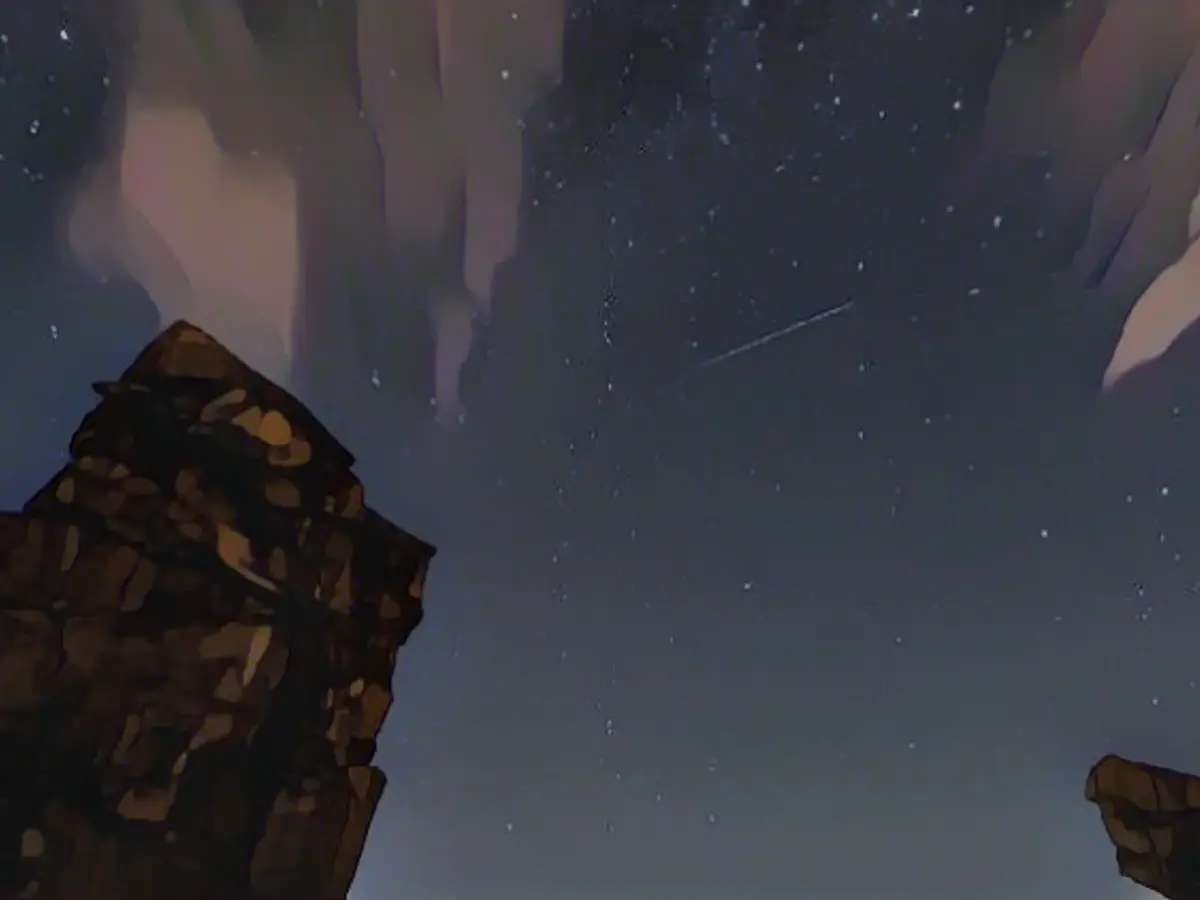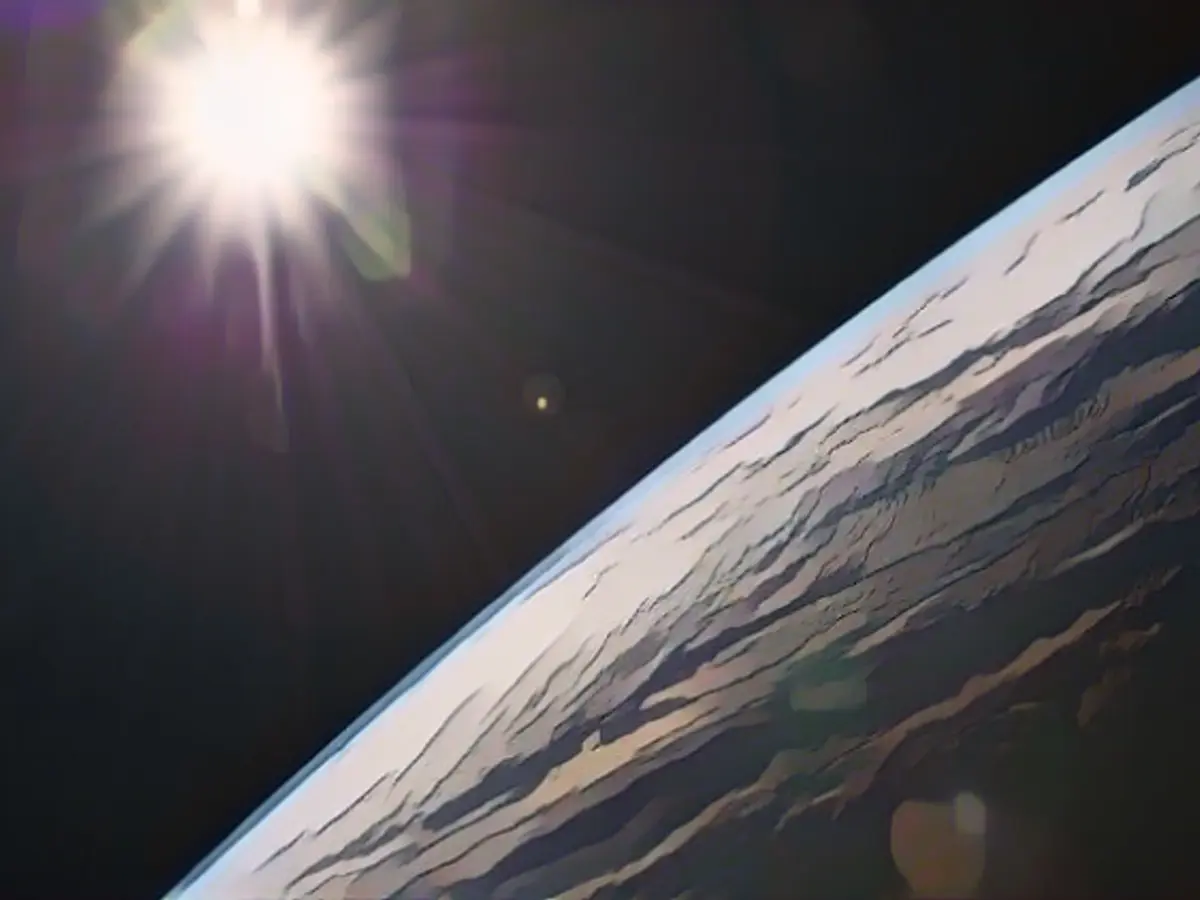Bright comet and lunar eclipse visible
The giant planet Jupiter shines in the sky on New Year's Eve. The new year - a leap year with a February 29 - has only one eclipse to offer in Central Europe, but a comet and several streams of shooting stars.
According to the Gregorian calendar, 2024 is a leap year with 366 days. February has 29 days instead of 28 as in common years. At the beginning of the year, the giant planet Jupiter shines in the night sky while the brightly shining Venus heralds the start of the year as the morning star. The brightest fixed star in the firmament, Sirius in the Great Dog, flickers in a bluish-white light half-high in the south-east.
Orion with the reddish shoulder star Betelgeuse and the base star Rigel can be seen in the south. High above our heads is the yellowish Kapella, the main star in the Guide. Aldebaran, the reddish bull's eye, attracts attention in the southwest. In the eastern sky you can see Gemini with its bright stars Castor and Pollux. The bright stars Sirius, Prokyon, Kastor, Kapella, Aldebaran and Rigel form the winter hexagon.
Bright comet expected
Comet C/2023 A3 Tsuchinshan Atlas, discovered on January 9, 2023, is expected to become a tail star that can be seen with the naked eye in October 2024. It will pass by Earth on 13 October 2024 at a distance of 70 million kilometers. It is currently not possible to give an exact brightness.
Solar and lunar eclipses
Four eclipses will occur in 2024. Of these, only the partial lunar eclipse on September 18 can be observed in Central Europe. It will take place in the second half of the night from September 17 to 18. At the peak of the eclipse at 4.44 a.m. summer time, only 9.1 percent of the full moon's apparent diameter will be in the Earth's umbra. The total solar eclipse on April 8 and the annular solar eclipse on October 2 will remain unobservable from Central Europe. This also applies to the penumbral lunar eclipse on March 25.
Important streams of shooting stars
Apart from occasional shooting stars, swarms of shooting stars appear more or less regularly when the Earth crosses the cluster of a meteor stream. As a general rule, more shooting stars can usually be observed in the second half of the night, as the Earth's apex, i.e. the target point of the Earth's orbit around the sun, reaches its highest position in the south at 6 am. In a sense, you are moving through space with your face forward. Collisions with meteoritic material are therefore more frequent in the morning than in the evening.

The Quadrantids can be expected right at the beginning of the year. From January 1 to 10, they flare up in the second half of the night. The radiant only reaches a greater height after midnight, which is why it is worth keeping an eye out for the Quadrantids in the morning hours.
On the night of January 3 to 4, the peak maximum occurs after midnight - with around 100 objects per hour. In some years, over two hundred meteors per hour have even been observed. Bright shooting stars are rare.
The large number of meteors in the first few days of August is due to the stream of Perseids, whose maximum activity is between August 9 and 13. Bright objects, so-called fireballs or bolides, are not uncommon. The maximum can be expected on August 12 in the evening hours. The most beautiful stream of the year brings up to 100 shooting stars per hour.
From November 13 to 30, the Leonids are in action in the morning sky. The maximum is expected on the morning of November 17. This time, a rate of 15 meteors per hour can be expected. The shooting stars are extremely fast, around 70 kilometers per second. The best viewing time is after midnight.
Visibility of the planets
Venus, the brightest planet in the earthly firmament, plays its role as the morning star at the beginning of the year. It leaves the morning sky in March and appears in the evening sky in August. It remains there until after the end of the year. As the closest planet to the sun, the nimble Mercury is difficult to observe. It can only be seen for a few days a year low in the west at dusk or in the morning just above the eastern horizon before the sun rises. It appears in the evening sky in mid to late March and in the morning sky in mid-January, early September and late December.
Mars first appears in the morning sky in the east towards the end of May. By the end of the year, it becomes the planet of the entire night, becoming increasingly brighter and shining conspicuously high in the sky around midnight in December. Jupiter can be observed as a brightly shining planet in the evening sky from January to the end of April. It appears in the morning sky around mid-June. In summer and fall, it rises earlier and earlier. Finally, the giant planet comes into opposition to the sun in the constellation Taurus on December 7. It can then be seen as a brightly shining planet all night long.
Saturn can still be found in the evening sky in the southwest at the beginning of the year. The ringed planet appears in the morning sky at the end of March. It is then in opposition to the sun on September 8. In the telescope you can see the ring, which is now slightly inclined to the Earth. The ringed planet remains in the evening sky until the end of December. The planets Uranus and Neptune, which are far from the sun, cannot be seen with the naked eye.
Calendar dates 2024
The astronomical year 2024 does not begin at midnight, but on December 31, 2023 at 9.18 pm. The sun will then pass the point 280 degrees east of the vernal equinox in its apparent annual orbit.
The Julian calendar, which is still used in many Orthodox churches today, lags behind the Gregorian calendar by 13 days. January 14, 2024 in the Gregorian calendar therefore corresponds to January 1, 2024 in the Julian calendar.
The Jewish year 5785 begins at sunset on October 2. The Jewish New Year therefore falls on October 3, 2024. The Islamic year 1446 also begins at sunset on July 7. The first day of the Islamic year 1446 therefore corresponds to July 8, 2024.
The new year in the traditional Chinese calendar begins on February 10, 2024. It is the Year of the Dragon. Since the beginning of the Chinese calendar, 4721 years will have passed.
The sun is the regent of the year 2024. It was once believed that the annual regents determined the general weather situation in the respective year. Annual rulers can be the sun, moon, Mercury, Venus, Mars, Jupiter and Saturn.
Public holidays and summer time
Easter Sunday falls on March 31 in 2024. New Year's Day is a Monday and New Year's Eve falls on a Tuesday. Ash Wednesday is on February 14, Ascension Day on May 9, Pentecost Sunday on May 19 and Corpus Christi on Thursday, May 30. The 1st Advent falls on Sunday, December 1, and Christmas Eve is on Tuesday, December 24. Central European Summer Time (CEST) will apply from Sunday, March 31 to Sunday, October 27 in 2024.
Course of the sun and seasons in 2024
In the early hours of 3 January, the Earth races through its closest orbital point to the sun at a speed of 30 kilometers per second, or 108,000 kilometers per hour, with the sun's distance this time measuring 147,100,630 kilometers. The sunlight covers this distance in eight minutes and ten seconds.
Astronomical spring arrives early in the morning on March 20. At exactly 4.06 a.m., the sun crosses the celestial equator from south to north and thus moves to the northern hemisphere of the firmament. The equinox occurs.
Summer begins on June 20 at 10:51 p.m. CEST (Central European Summer Time), when the sun reaches the peak of its apparent annual path through the zodiac. The summer point is identical to the beginning of the zodiac sign of Cancer. After passing the summer point, the sun no longer rises, but sinks back down to the celestial equator over the following weeks. It then crosses it on September 22 at 14:44 CEST, this time from north to south. Another equinox occurs on this day. After September 22, the nights are again longer than the days in our latitudes.
In the early morning of July 5, the Earth passes through its furthest point from the sun. This year, 152,099,970 kilometers separate us from the sun. The sunlight will then have traveled to Earth for eight minutes and 27 seconds, which is 17 seconds longer than when it was close to the Earth at the beginning of January. On December 21, 2024, at 10.21 a.m., the sun will reach its lowest point of the year and astronomical winter will begin.
Read also:
- This will change in December
- Attacks on ships in the Red Sea: shipping companies avoid important trade route
- Houthi rebels want to launch further attacks despite international coalition
- USA forms military coalition against Houthi attacks on ships in the Red Sea
The new year, being a leap year with 366 days, offers a lunar eclipse and a bright comet to Central Europe. The comet, named C/2023 A3 Tsuchinshan Atlas, was discovered in January 2023 and is expected to become visible with the naked eye in October 2024. Astronomy enthusiasts might also look forward to observing Mars, Venus, Jupiter, and other planets in the night sky during this period. Astrology, a belief that the positions of stars and planets can influence people's lives, continues to be a topic of interest for many. Additionally, several streams of shooting stars, such as the Quadrantids and Perseids, can be seen in the night sky throughout the year. The radiant of the Quadrantids is only visible after midnight, making the early morning hours an optimal time to spot these shooting stars.
Source: www.ntv.de







